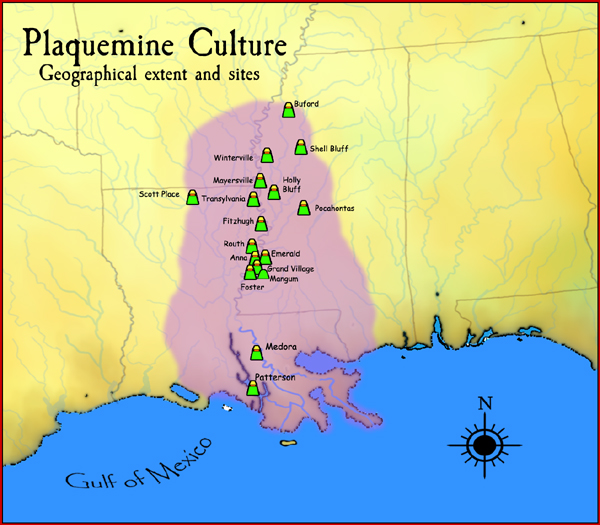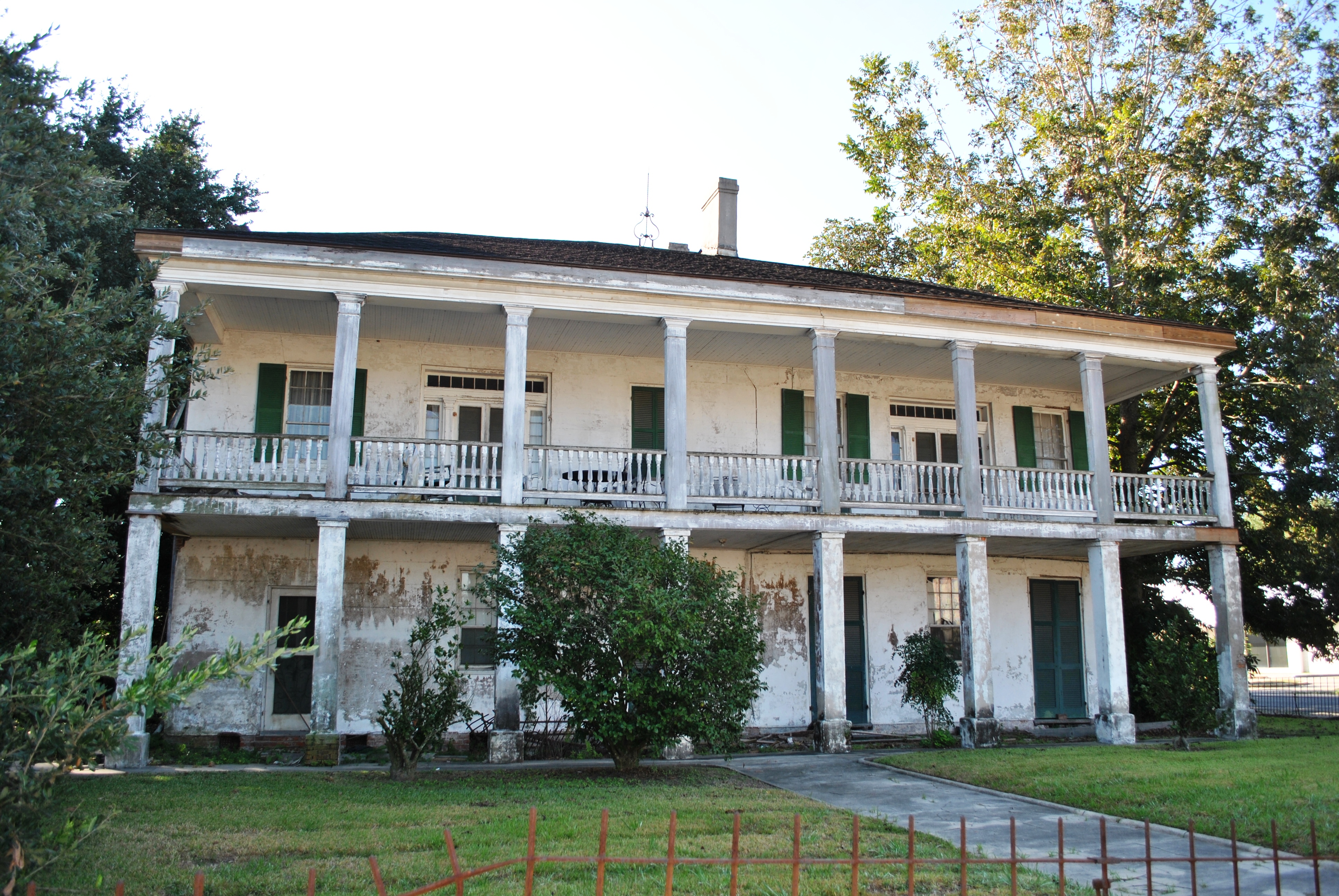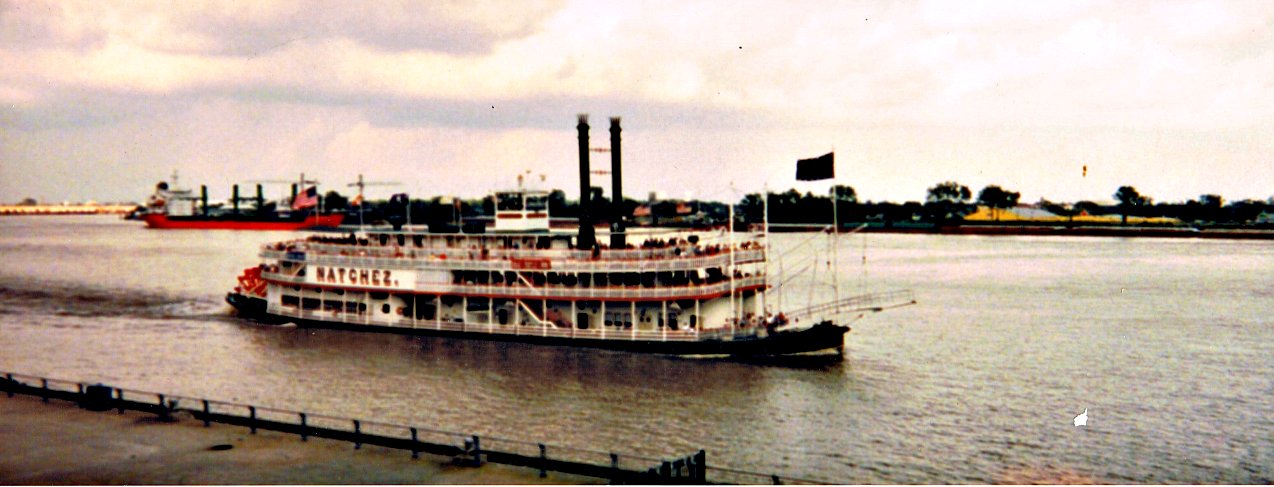|
Medora Site
The Medora site ( 16WBR1) is an archaeological site that is a type site for the prehistoric Plaquemine culture period. The name for the culture is taken from the proximity of Medora to the town of Plaquemine, Louisiana. The site is in West Baton Rouge Parish, Louisiana, and was inhabited from approximately 1300 to 1600 CE. It consisted of two mounds separated by a plaza. In the winter of 1939-40 excavation of this site was undertaken by the Louisiana State Archaeological Survey, a joint project of Louisiana State University and the Work Projects Administration. It was directed by James A. Ford, and George I. Quimby. The excavations of the site were instrumental in defining the characteristics of the Plaquemine period and culture. The Medora site Location The Medora site is located in West Baton Rouge Parish, Louisiana adjacent to Bayou Bourbeaux (or Bourbeau or Bourbaux) on the flood plain of Manchac Point (also called Australia Point). Manchac Point is a hair-pin bend of th ... [...More Info...] [...Related Items...] OR: [Wikipedia] [Google] [Baidu] |
Plaquemine, Louisiana
Plaquemine is a city in and the parish seat of Iberville Parish, Louisiana, United States. It is part of the Baton Rouge metropolitan statistical area. At the 2010 United States census, the population was 7,119; the 2020 census determined its population was 6,269. History Early inhabitants of the area were the Chitimacha people. Pierre Le Moyne d'Iberville claimed all of Louisiana in 1699 for King Louis XIV of France. Plaquemine was settled by 1775 and named for the Native word ''Plakemine'', which means persimmon. Due to its location at the juncture of the Bayou Plaquemine and the Mississippi River, the village soon began to prosper and grow, beginning a long history of prosperity. By 1838, the town was incorporated, electing Zénon Labauve, for whom a street in New Orleans' Garden District is named, as its first mayor. Plaquemine continued to grow in the Antebellum era. Massive plantations were established in nearby regions, including St. Louis, Nottoway, and Belle Gr ... [...More Info...] [...Related Items...] OR: [Wikipedia] [Google] [Baidu] |
Manchac Point
Manchac (also known as Akers) is an unincorporated community in Tangipahoa Parish, Louisiana, United States. Etymology Dr. John R. Swanton, a linguist who worked with Native American languages, suggested that the name Manchac is derived from ''Imashaka'', which is a Choctaw word meaning "the rear entrance." An early Choctaw language dictionary written by Cyrus Byington defines the word ''im'' as a preposition meaning "place" and ''ashaka'' meaning "the back side or rear" Willie Akers Willie Akers carried the same name as his father who founded the city of Ponchatoula. In the year 1871 Willie moved to Manchac with his family and built a house near a section of high ground that the locals called ''Jones Island''. Then in the year 1857 Willie was appointed as the first postmaster of Manchac and served as the local telegraph operator. The local community became known as "Akers" during this period. History Fort Bute or Manchac Post, named after the then British Prime Minister Jo ... [...More Info...] [...Related Items...] OR: [Wikipedia] [Google] [Baidu] |
Greenstone (archaeology)
Greenstone is a common generic term for valuable, green-hued minerals and metamorphosed igneous rocks and stones which early cultures used in the fashioning of hardstone carvings such as jewelry, statuettes, ritual tools, and various other artifacts. Greenstone artifacts may be made of greenschist, chlorastrolite, serpentine, omphacite, chrysoprase, olivine, nephrite, chloromelanite among other green-hued minerals. The term also includes jade and jadeite, although these are perhaps more frequently identified by these latter terms. The greenish hue of these rocks generally derives from the presence of minerals such as chlorite, hornblende, or epidote.Kipfer (2000, p.218) Greenstone minerals were presumably selected for their color rather than their chemical composition. In archaeology therefore, having a loosely applied general term is at least partially influenced by the observation that ancient cultures often used and considered these various green-hued materials as interchan ... [...More Info...] [...Related Items...] OR: [Wikipedia] [Google] [Baidu] |
Mississippian Culture Pottery
Mississippian culture pottery is the ceramic tradition of the Mississippian culture (800 to 1600 CE) found as artifacts in archaeological sites in the American Midwest and Southeast. It is often characterized by the adoption and use of riverine (or more rarely marine) shell- tempering agents in the clay paste. Shell tempering is one of the hallmarks of Mississippian cultural practices. Analysis of local differences in materials, techniques, forms, and designs is a primary means for archaeologists to learn about the lifeways, religious practices, trade, and interaction among Mississippian peoples. The value of this pottery on the illegal antiquities market has led to extensive looting of sites. Materials and techniques Mississippian culture pottery was made from locally available clay sources, which often gives archaeologists clues as to where a specific example originated. The clay was tempered with an additive to keep it from shrinking and cracking in the drying and firing pro ... [...More Info...] [...Related Items...] OR: [Wikipedia] [Google] [Baidu] |
Plaquemine Culture Pottery
The Plaquemine culture was an archaeological culture (circa 1200 to 1700 CE) centered on the Lower Mississippi River valley. It had a deep history in the area stretching back through the earlier Coles Creek (700-1200 CE) and Troyville cultures (400-700 CE) to the Marksville culture (100 BCE to 400 CE). The Natchez and related Taensa peoples were their historic period descendants. The type site for the culture is the Medora site in Louisiana; while other examples include the Anna, Emerald, Holly Bluff, and Winterville sites in Mississippi. History Definition The Plaquemine culture was a Mississippian culture variant centered on the Mississippi River valley, stretching from the Gulf of Mexico to just south of its junction with the Arkansas River, encompassing the Yazoo River basin and Natchez Bluffs in western Mississippi, and the lower Ouachita and Red River valleys in southeastern Arkansas, and eastern Louisiana. They were primarily agriculturists who grew maize, pumpkins ... [...More Info...] [...Related Items...] OR: [Wikipedia] [Google] [Baidu] |
Winterville Pottery HRoe 2004 , a festival in Birmingham, England, that is often referred to as "Winterville"
{{Disambiguation, geo ...
Winterville or Wintersville may refer to: * Winterville (band), a British-based blues-rock trio ;Places in the United States * Winterville, Georgia * Wintersville, Missouri * Winterville, North Carolina * Wintersville, Ohio * Wintersville, Pennsylvania * Winterville Plantation, Maine * Winterville site See also *Winterval Winterval was a season of public events in Birmingham, England, organised by Birmingham City Council in each of two consecutive winters: first from 20 November to 31 December 1997, and then again from mid-October 1998 to mid-January 1999. The in ... [...More Info...] [...Related Items...] OR: [Wikipedia] [Google] [Baidu] |
Platform Mound
Platform may refer to: Technology * Computing platform, a framework on which applications may be run * Platform game, a genre of video games * Car platform, a set of components shared by several vehicle models * Weapons platform, a system or structure that carries weapons * Web platform * Platform economy (or Platform capitalism, Platformization), a structure of internet business Physical objects and features * Carbonate platform, a type of sedimentary body * Cargo platform, a pallet used to ship cargo and heavy machines by forklift or manual lift * Diving platform, used in diving * Jumping platform, naturally occurring platforms, or platforms made in an ''ad hoc'' way for cliff jumping * Oil platform, a structure built for oil production * Platform, a component of scaffolding * Platform (geology), the part of a continental craton that is covered by sedimentary rocks * Platform (shopping center) in Culver City, Greater Los Angeles, California * Theatre platform, a standa ... [...More Info...] [...Related Items...] OR: [Wikipedia] [Google] [Baidu] |
Natchez, Mississippi
Natchez ( ) is the county seat of and only city in Adams County, Mississippi, United States. Natchez has a total population of 14,520 (as of the 2020 census). Located on the Mississippi River across from Vidalia in Concordia Parish, Louisiana, Natchez was a prominent city in the antebellum years, a center of cotton planters and Mississippi River trade. Natchez is some southwest of Jackson, the capital of Mississippi, which is located near the center of the state. It is approximately north of Baton Rouge, Louisiana, located on the lower Mississippi River. Natchez is the 25th-largest city in the state. The city was named for the Natchez tribe of Native Americans, who with their ancestors, inhabited much of the area from the 8th century AD through the French colonial period. History Established by French colonists in 1716, Natchez is one of the oldest and most important European settlements in the lower Mississippi River Valley. After the French lost the French and India ... [...More Info...] [...Related Items...] OR: [Wikipedia] [Google] [Baidu] |
Mississippi River
The Mississippi River is the second-longest river and chief river of the second-largest drainage system in North America, second only to the Hudson Bay drainage system. From its traditional source of Lake Itasca in northern Minnesota, it flows generally south for to the Mississippi River Delta in the Gulf of Mexico. With its many tributaries, the Mississippi's watershed drains all or parts of 32 U.S. states and two Canadian provinces between the Rocky and Appalachian mountains. The main stem is entirely within the United States; the total drainage basin is , of which only about one percent is in Canada. The Mississippi ranks as the thirteenth-largest river by discharge in the world. The river either borders or passes through the states of Minnesota, Wisconsin, Iowa, Illinois, Missouri, Kentucky, Tennessee, Arkansas, Mississippi, and Louisiana. Native Americans have lived along the Mississippi River and its tributaries for thousands of years. Most were hunter-ga ... [...More Info...] [...Related Items...] OR: [Wikipedia] [Google] [Baidu] |
Meander
A meander is one of a series of regular sinuous curves in the channel of a river or other watercourse. It is produced as a watercourse erodes the sediments of an outer, concave bank ( cut bank) and deposits sediments on an inner, convex bank which is typically a point bar. The result of this coupled erosion and sedimentation is the formation of a sinuous course as the channel migrates back and forth across the axis of a floodplain. The zone within which a meandering stream periodically shifts its channel is known as a meander belt. It typically ranges from 15 to 18 times the width of the channel. Over time, meanders migrate downstream, sometimes in such a short time as to create civil engineering challenges for local municipalities attempting to maintain stable roads and bridges.Neuendorf, K.K.E., J.P. Mehl Jr., and J.A. Jackson, J.A., eds. (2005) ''Glossary of Geology'' (5th ed.). Alexandria, Virginia, American Geological Institute. 779 pp. Charlton, R., 2007. ''Fundamentals ... [...More Info...] [...Related Items...] OR: [Wikipedia] [Google] [Baidu] |
Harold Norman Fisk
Harold may refer to: People * Harold (given name), including a list of persons and fictional characters with the name * Harold (surname), surname in the English language * András Arató, known in meme culture as "Hide the Pain Harold" Arts and entertainment * ''Harold'' (film), a 2008 comedy film * ''Harold'', an 1876 poem by Alfred, Lord Tennyson * ''Harold, the Last of the Saxons'', an 1848 book by Edward Bulwer-Lytton, 1st Baron Lytton * ''Harold or the Norman Conquest'', an opera by Frederic Cowen * ''Harold'', an 1885 opera by Eduard Nápravník * Harold, a character from the cartoon ''The Grim Adventures of Billy & Mandy'' *Harold & Kumar, a US movie; Harold/Harry is the main actor in the show. Places ;In the United States * Alpine, Los Angeles County, California, an erstwhile settlement that was also known as Harold * Harold, Florida, an unincorporated community * Harold, Kentucky, an unincorporated community * Harold, Missouri, an unincorporated community ... [...More Info...] [...Related Items...] OR: [Wikipedia] [Google] [Baidu] |
Louisiana Geological Survey
The Louisiana Geological Survey is a state geological survey established by the Louisiana legislature by Act 131 in 1934 to serve the citizens Louisiana by collecting, preserving, and disseminating impartial information on the geomorphology, hydrogeology, geology, paleontology, economic geology, and geological resources of Louisiana. The Louisiana Geological Survey was originally part of the Louisiana Department of Conservation. Later it was a division of the Louisiana Department of Natural Resources and finally transferred by the Louisiana legislature's HB 2353 to Louisiana State University. At Louisiana State University, it is part of the Office of Research and Economic Development.Anonymous (2008a''General Information'', Louisiana State University, Baton Rouge, Louisiana. Activities Over the years, the Louisiana Geological Survey has been involved in a wide range research concerning economic, groundwater, and environmental geology of Louisiana. For example, the Louisiana Geolog ... [...More Info...] [...Related Items...] OR: [Wikipedia] [Google] [Baidu] |






